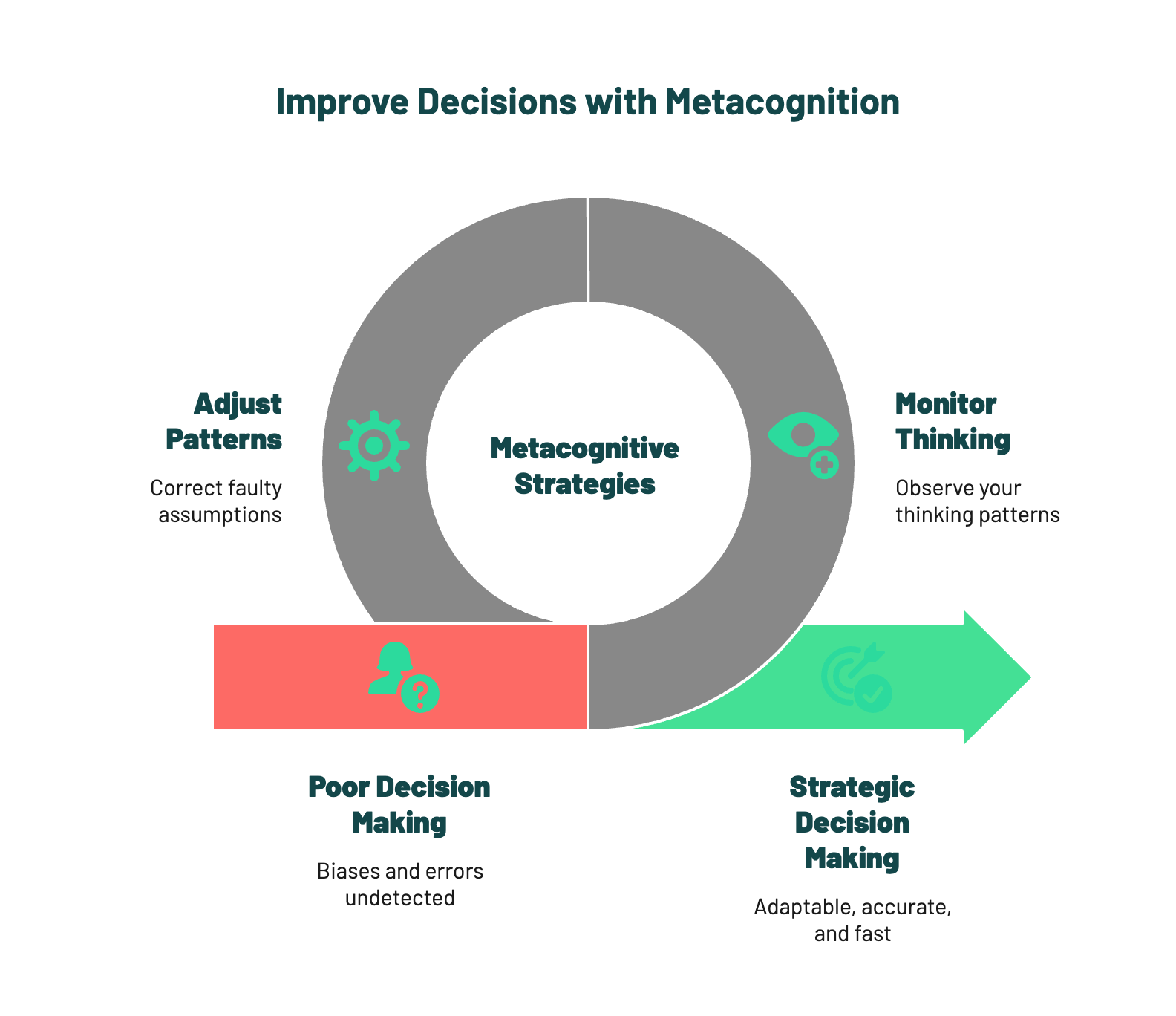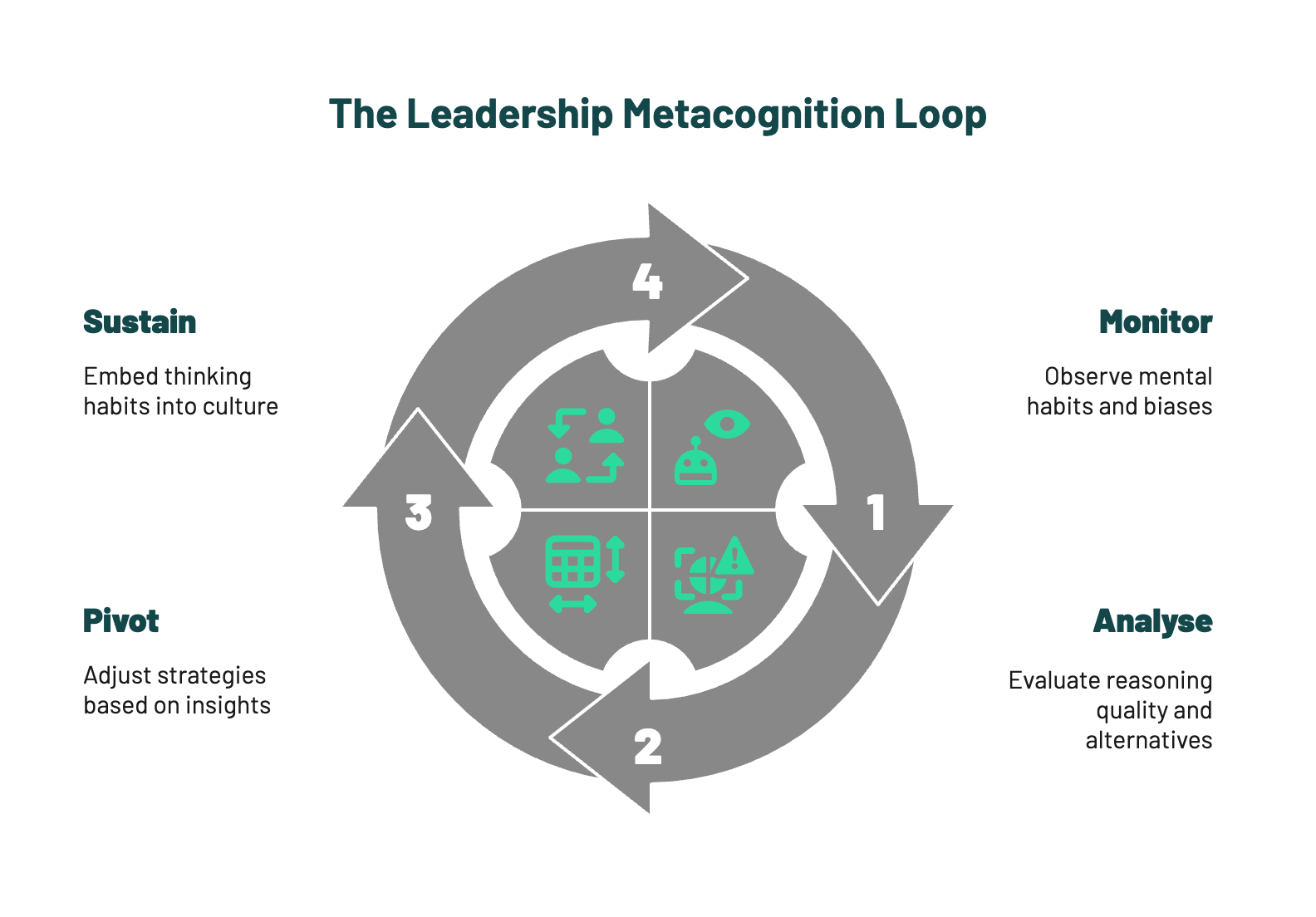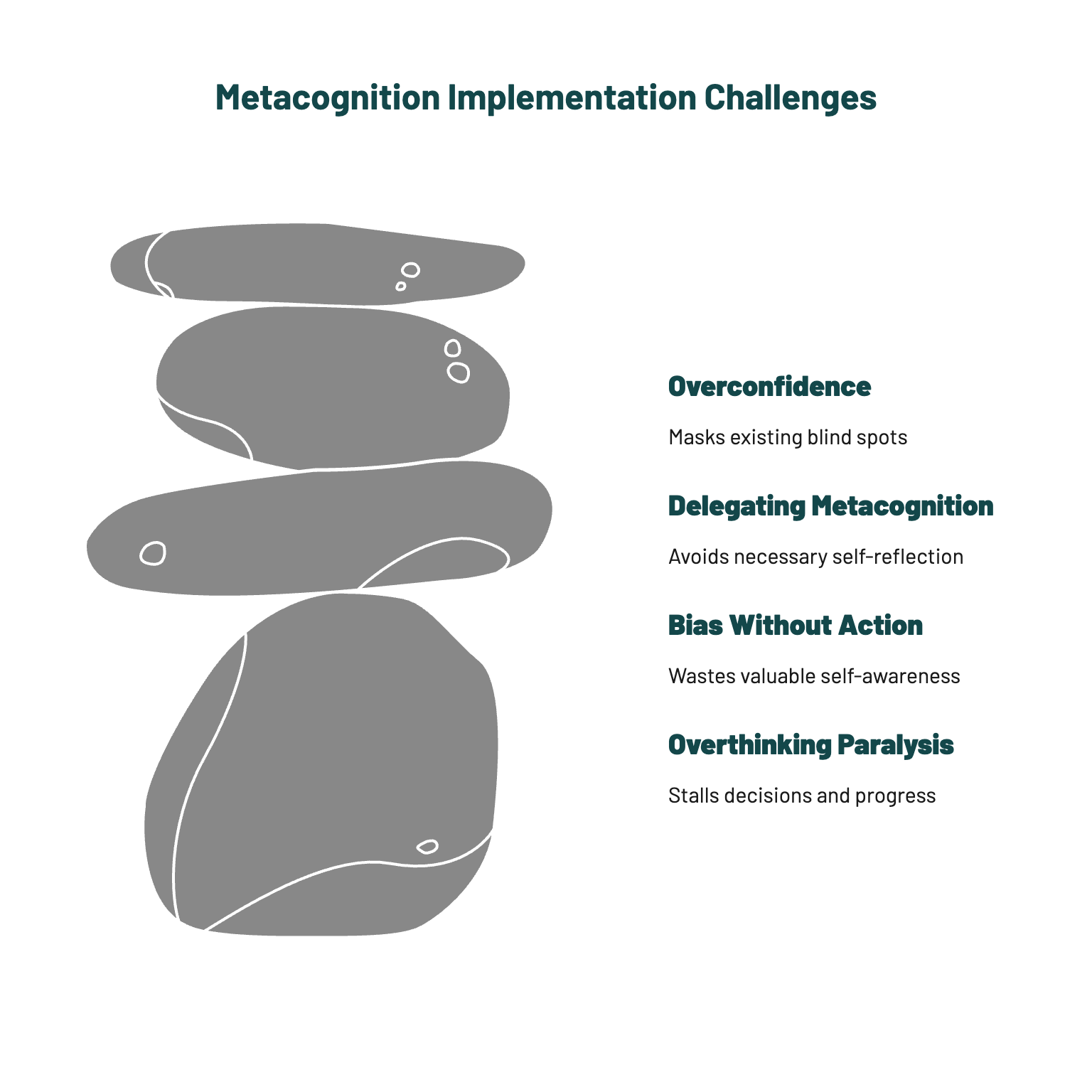Leadership
August 14, 2025
5
Min
The Most Underrated Leadership Skill? Metacognition
metacognition
|
This is the essence of metacognition – the awareness and regulation of your own thinking processes. For leaders juggling complex decisions, competing priorities, and diverse teams, metacognition is not a nice-to-have. It is the difference between being swept along by cognitive autopilot and steering your own mind with precision.
In leadership, the quality of your thinking determines the quality of your decisions. And yet, research suggests that we are poor at detecting our own biases and errors in real time. A study published in Organizational Behavior and Human Decision Processes found that leaders who engaged in metacognitive strategies were better at adapting to ambiguous and fast-changing scenarios, outperforming peers on both speed and accuracy.
This matters because the higher up you are, the less direct feedback you receive. People defer to your authority. Your calendar fills with decisions that affect millions in revenue or thousands of livelihoods. Without a disciplined way to monitor and adjust your own thinking patterns, you risk becoming overconfident, blind to faulty assumptions, or locked into outdated mental models.

We think of metacognition for leaders as a loop – a continual cycle of monitoring, evaluating, and adjusting thought processes in real time. Our 4-part framework can be remembered as MAPS: Monitor, Analyse, Pivot, Sustain.
This is the observational layer – catching yourself in the act of thinking. Do you tend to default to risk-aversion in uncertainty? Are you swayed by the last opinion you heard? Monitoring builds a running awareness of these tendencies.
Example: In one executive team we coached, the CEO realised during budget reviews that he consistently gave more weight to arguments presented with data visualisations than to equally valid qualitative input. Simply noticing this bias altered how he ran meetings.
Reflection prompt: In the last week, when did you make a decision on instinct without stopping to ask, “What’s influencing my choice right now?”
Micro-action: Add a simple “pause and label” habit before major decisions – identify your dominant thought pattern in the moment.
Analysis moves beyond spotting patterns into evaluating them. Are your mental shortcuts (heuristics) serving you in this context? Are you missing alternative explanations?
Example: A regional director for a retail chain noticed that her belief in “bigger stores equal bigger profits” was rooted in early career experiences, not recent data. Analysing her own reasoning allowed her to greenlight smaller, high-margin concept stores that became a growth engine.
Micro-action: For one decision this week, write down your top three reasons and challenge each with “What if the opposite were true?”
This is the agility point – making live adjustments when you realise your current thought path is flawed or incomplete. Pivoting is often uncomfortable because it can feel like admitting you were wrong, but in practice it is a hallmark of adaptive leadership.
Example: A CIO in a digital transformation project initially pushed for a single platform solution. Midway through, he recognised he was falling into “solutioneering” without fully mapping user needs. He pivoted to a phased approach, winning broader adoption and reducing risk.
Micro-action: In your next project update, name one assumption that has changed since kick-off and why.
Metacognition is most powerful when embedded into team norms, not just individual practice. Encourage a language of thinking – ask your team to name the type of reasoning they are using (“We’re in hypothesis testing mode” or “We’re drawing analogies”).
Example: A COO introduced “thinking rounds” in strategic offsites, where each participant stated not only their conclusion but how they arrived at it. This simple practice improved both the quality and transparency of decision-making.
Micro-action: Add a debrief question to key meetings: “How did we think our way here?”

Metacognition can feel abstract, but it has practical levers in a leader’s daily rhythm. Here’s how to operationalise it.
Pro Tip: Use low-stakes situations (like choosing vendors for a minor service) to practise metacognitive skills so they become automatic in high-stakes moments.
Even experienced leaders can falter when applying metacognition. Common pitfalls include:

Think about a decision you made in the last month that didn’t play out as expected. Which part of your thinking process, if examined in real time, could have changed the outcome?
When was the last time you changed your mind mid-project? How did you recognise the need, and what signals might you watch for earlier next time?
Leaders who practise metacognition consistently report sharper decision-making, reduced blind spots, and stronger team trust. It supports faster strategic pivots without sacrificing rigour, and it creates cultures where reasoning is as valued as results.
The cumulative effect is not just better thinking in the moment, but an organisational capacity to adapt, learn, and self-correct without waiting for crises.
This week, pick one major decision and run it through the MAPS loop in real time. Make your thinking visible to at least one other senior colleague. Then compare the outcome – and the quality of discussion – to your usual process.
Team SHIFT
What if the biggest blind spot in your leadership toolkit isn’t a missing technical skill or a gap in industry knowledge, but the ability to notice how you think while you are thinking?
This is the essence of metacognition – the awareness and regulation of your own thinking processes. For leaders juggling complex decisions, competing priorities, and diverse teams, metacognition is not a nice-to-have. It is the difference between being swept along by cognitive autopilot and steering your own mind with precision.
In leadership, the quality of your thinking determines the quality of your decisions. And yet, research suggests that we are poor at detecting our own biases and errors in real time. A study published in Organizational Behavior and Human Decision Processes found that leaders who engaged in metacognitive strategies were better at adapting to ambiguous and fast-changing scenarios, outperforming peers on both speed and accuracy.
This matters because the higher up you are, the less direct feedback you receive. People defer to your authority. Your calendar fills with decisions that affect millions in revenue or thousands of livelihoods. Without a disciplined way to monitor and adjust your own thinking patterns, you risk becoming overconfident, blind to faulty assumptions, or locked into outdated mental models.

We think of metacognition for leaders as a loop – a continual cycle of monitoring, evaluating, and adjusting thought processes in real time. Our 4-part framework can be remembered as MAPS: Monitor, Analyse, Pivot, Sustain.
This is the observational layer – catching yourself in the act of thinking. Do you tend to default to risk-aversion in uncertainty? Are you swayed by the last opinion you heard? Monitoring builds a running awareness of these tendencies.
Example: In one executive team we coached, the CEO realised during budget reviews that he consistently gave more weight to arguments presented with data visualisations than to equally valid qualitative input. Simply noticing this bias altered how he ran meetings.
Reflection prompt: In the last week, when did you make a decision on instinct without stopping to ask, “What’s influencing my choice right now?”
Micro-action: Add a simple “pause and label” habit before major decisions – identify your dominant thought pattern in the moment.
Analysis moves beyond spotting patterns into evaluating them. Are your mental shortcuts (heuristics) serving you in this context? Are you missing alternative explanations?
Example: A regional director for a retail chain noticed that her belief in “bigger stores equal bigger profits” was rooted in early career experiences, not recent data. Analysing her own reasoning allowed her to greenlight smaller, high-margin concept stores that became a growth engine.
Micro-action: For one decision this week, write down your top three reasons and challenge each with “What if the opposite were true?”
This is the agility point – making live adjustments when you realise your current thought path is flawed or incomplete. Pivoting is often uncomfortable because it can feel like admitting you were wrong, but in practice it is a hallmark of adaptive leadership.
Example: A CIO in a digital transformation project initially pushed for a single platform solution. Midway through, he recognised he was falling into “solutioneering” without fully mapping user needs. He pivoted to a phased approach, winning broader adoption and reducing risk.
Micro-action: In your next project update, name one assumption that has changed since kick-off and why.
Metacognition is most powerful when embedded into team norms, not just individual practice. Encourage a language of thinking – ask your team to name the type of reasoning they are using (“We’re in hypothesis testing mode” or “We’re drawing analogies”).
Example: A COO introduced “thinking rounds” in strategic offsites, where each participant stated not only their conclusion but how they arrived at it. This simple practice improved both the quality and transparency of decision-making.
Micro-action: Add a debrief question to key meetings: “How did we think our way here?”

Metacognition can feel abstract, but it has practical levers in a leader’s daily rhythm. Here’s how to operationalise it.
Pro Tip: Use low-stakes situations (like choosing vendors for a minor service) to practise metacognitive skills so they become automatic in high-stakes moments.
Even experienced leaders can falter when applying metacognition. Common pitfalls include:

Think about a decision you made in the last month that didn’t play out as expected. Which part of your thinking process, if examined in real time, could have changed the outcome?
When was the last time you changed your mind mid-project? How did you recognise the need, and what signals might you watch for earlier next time?
Leaders who practise metacognition consistently report sharper decision-making, reduced blind spots, and stronger team trust. It supports faster strategic pivots without sacrificing rigour, and it creates cultures where reasoning is as valued as results.
The cumulative effect is not just better thinking in the moment, but an organisational capacity to adapt, learn, and self-correct without waiting for crises.
This week, pick one major decision and run it through the MAPS loop in real time. Make your thinking visible to at least one other senior colleague. Then compare the outcome – and the quality of discussion – to your usual process.
Team SHIFT
What if the biggest blind spot in your leadership toolkit isn’t a missing technical skill or a gap in industry knowledge, but the ability to notice how you think while you are thinking?
This is the essence of metacognition – the awareness and regulation of your own thinking processes. For leaders juggling complex decisions, competing priorities, and diverse teams, metacognition is not a nice-to-have. It is the difference between being swept along by cognitive autopilot and steering your own mind with precision.
In leadership, the quality of your thinking determines the quality of your decisions. And yet, research suggests that we are poor at detecting our own biases and errors in real time. A study published in Organizational Behavior and Human Decision Processes found that leaders who engaged in metacognitive strategies were better at adapting to ambiguous and fast-changing scenarios, outperforming peers on both speed and accuracy.
This matters because the higher up you are, the less direct feedback you receive. People defer to your authority. Your calendar fills with decisions that affect millions in revenue or thousands of livelihoods. Without a disciplined way to monitor and adjust your own thinking patterns, you risk becoming overconfident, blind to faulty assumptions, or locked into outdated mental models.

We think of metacognition for leaders as a loop – a continual cycle of monitoring, evaluating, and adjusting thought processes in real time. Our 4-part framework can be remembered as MAPS: Monitor, Analyse, Pivot, Sustain.
This is the observational layer – catching yourself in the act of thinking. Do you tend to default to risk-aversion in uncertainty? Are you swayed by the last opinion you heard? Monitoring builds a running awareness of these tendencies.
Example: In one executive team we coached, the CEO realised during budget reviews that he consistently gave more weight to arguments presented with data visualisations than to equally valid qualitative input. Simply noticing this bias altered how he ran meetings.
Reflection prompt: In the last week, when did you make a decision on instinct without stopping to ask, “What’s influencing my choice right now?”
Micro-action: Add a simple “pause and label” habit before major decisions – identify your dominant thought pattern in the moment.
Analysis moves beyond spotting patterns into evaluating them. Are your mental shortcuts (heuristics) serving you in this context? Are you missing alternative explanations?
Example: A regional director for a retail chain noticed that her belief in “bigger stores equal bigger profits” was rooted in early career experiences, not recent data. Analysing her own reasoning allowed her to greenlight smaller, high-margin concept stores that became a growth engine.
Micro-action: For one decision this week, write down your top three reasons and challenge each with “What if the opposite were true?”
This is the agility point – making live adjustments when you realise your current thought path is flawed or incomplete. Pivoting is often uncomfortable because it can feel like admitting you were wrong, but in practice it is a hallmark of adaptive leadership.
Example: A CIO in a digital transformation project initially pushed for a single platform solution. Midway through, he recognised he was falling into “solutioneering” without fully mapping user needs. He pivoted to a phased approach, winning broader adoption and reducing risk.
Micro-action: In your next project update, name one assumption that has changed since kick-off and why.
Metacognition is most powerful when embedded into team norms, not just individual practice. Encourage a language of thinking – ask your team to name the type of reasoning they are using (“We’re in hypothesis testing mode” or “We’re drawing analogies”).
Example: A COO introduced “thinking rounds” in strategic offsites, where each participant stated not only their conclusion but how they arrived at it. This simple practice improved both the quality and transparency of decision-making.
Micro-action: Add a debrief question to key meetings: “How did we think our way here?”

Metacognition can feel abstract, but it has practical levers in a leader’s daily rhythm. Here’s how to operationalise it.
Pro Tip: Use low-stakes situations (like choosing vendors for a minor service) to practise metacognitive skills so they become automatic in high-stakes moments.
Even experienced leaders can falter when applying metacognition. Common pitfalls include:

Think about a decision you made in the last month that didn’t play out as expected. Which part of your thinking process, if examined in real time, could have changed the outcome?
When was the last time you changed your mind mid-project? How did you recognise the need, and what signals might you watch for earlier next time?
Leaders who practise metacognition consistently report sharper decision-making, reduced blind spots, and stronger team trust. It supports faster strategic pivots without sacrificing rigour, and it creates cultures where reasoning is as valued as results.
The cumulative effect is not just better thinking in the moment, but an organisational capacity to adapt, learn, and self-correct without waiting for crises.
This week, pick one major decision and run it through the MAPS loop in real time. Make your thinking visible to at least one other senior colleague. Then compare the outcome – and the quality of discussion – to your usual process.
Team SHIFT
